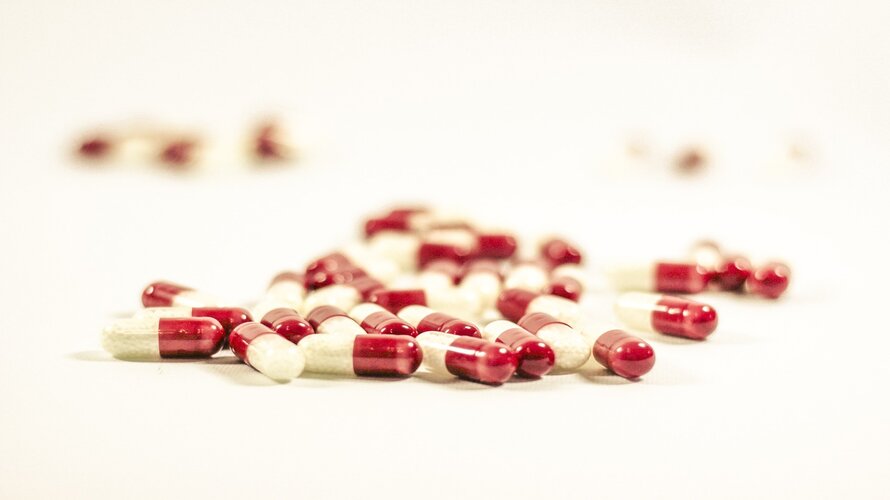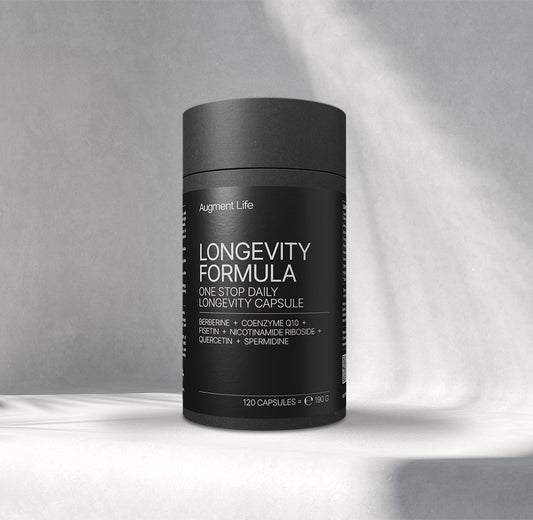Rapamycin (Sirolimus, Rapamune), a drug originally developed to prevent organ transplant rejection, has gained attention for its potential anti-aging properties. By inhibiting the mTOR pathway, which plays a crucial role in cell growth and metabolism, rapamycin has shown promising results in extending lifespan in animal studies.
This article explores the science behind rapamycin, its potential benefits for aging, and the current state of research as scientists investigate its viability as a tool for promoting longevity in humans.
What is rapamycin?
Rapamycin is a drug that inhibits the mTOR pathway, which is a major regulator of cell division and the entire aging process. If you want to know what the mTOR pathway exactly is, please read our article on it here: Are AMPK and mTOR pathways the molecular key to longevity?.
However, to understand what rapamycin does, it's enough to know that it stops or slows down the action of a major regulator of cell processes. Rapamycin is also known under the commercial names of Sirolimus or Rapamune, and is mostly prescribed as an immunosuppressant drug after organ transplantation.
Rapamycin can stop the white blood cells from recognizing and attacking the newly transplanted organ by disrupting certain signals that promote their growth and differentiation. This is beneficial in terms of transplantation, but can really decrease the ability of your immune system to fight off other infections as well (1).
The medically approved uses of rapamycin are:
- Prevention of organ transplant rejection (kidney transplants mostly),
- Treatment of lymphangioleiomyomatosis,
- Rapamycin and its analogs (rapalogs) are sometimes used in the treatment of advanced kidney cancer.

What foods contain rapamycin?
Rapamycin is not present in any foods, but it is naturally produced by a bacteria called Streptomyces hygroscopicus. This bacteria was first discovered in the soil of the Easter Island, whose native name is Rapa Nui. This is how rapamycin got its official name!
Today, rapamycin is mostly chemically synthesized to fulfill the amounts needed for the medical industry (2).
Rapamycin - Dosage for Humans
So far, rapamycin has only been approved as an immunosuppressant, for example after an organ donation. In this case, it's usually taken together with a corticosteroid. Even for this purpose, with many known cases, the proper dosage of rapamycin is going to be individual and determined by looking at your complete health report.
However, in most cases, the prescribed rapamycin dosage is the following:
- For prevention of kidney transplant rejection - 2 milligrams per day after an initial one-time dose of 6 mg, for adults weighing more than 40 kilograms.
- For treatment of lymphangioleiomyomatosis - 2 milligrams per day, for adults.
While there is, of course, also a lot of interest in the scientific community around rapamycin and its anti-aging benefits, rapamycin is not currently approved anywhere as a dietary supplement for that purpose.
However, there have been several human studies on rapamycin and aging, whose results are promising! In the next section, we will discuss what the outcomes of these studies were and what were the dosages that were applied.
Rapamycin - Anti Aging Benefits
As with any new potential drug or treatment, the research begins on laboratory models like cell culture and animals. A large sum of scientific evidence showed that inhibiting the mTOR pathway prolongs the lifespan of yeast cells, worms, fruit flies, and mice (3).
Scientists postulated that this happens because when mTOR is inhibited, the cell division keeps happening, and cell and protein degradation stop. This research also highlighted the mTOR as the central part of the aging process, and rapamycin as a very effective and strong inhibitor of mTOR.
This is a very exciting new potential use of rapamycin, and the anti-aging community is obviously eager to know more. This led to the conduction of just under twenty different human studies on the effects of rapamycin on aging and aging-related diseases.
As it is relatively difficult to follow one's lifespan (that would be a rather long and expensive study), most of the studies tested how rapamycin helps people suffering from age-related diseases.
Rapamycin - Dosage for Anti Aging
In the case of human studies on rapamycin effects, aging is considered as a state of cellular degradation which results in age-related diseases of different human systems. These were:
- cardiovascular system,
- muscular system,
- endocrine system,
- nervous system,
- immune system,
- integumentary system (skin, hair, and nails).
Out of these, rapamycin had a positive effect on improving the cardiovascular, immune, and integumentary systems. Other systems like the digestive, renal, or respiratory were not tested yet.
These were the outcomes of the studies where rapamycin had positive effects:
- Pulmonary hypertension patients had significantly better parameters after taking 0.75 mg of everolimus (rapamycin derivative)every 12 hours for 6 months. For example, their pulmonary arterial pressure and vascular resistance reduced, and maximum oxygen consumption and cardiac workload increased (4),
- Patients with macular degradation had significant improvements after taking 440 μg of intravitreal rapamycin every 2 months (three doses) (5),
- Taking 6 mg/day of everolimus orally, for 12 weeks, significantly improved the symptoms and state of patients suffering from rheumatoid arthritis (6),
- Taking everolimus (0·5 mg/day or 5 mg/week orally, for 6 weeks) when getting an influenza vaccine shot increased the effectiveness of the vaccine in older patients (7),
- In healthy individuals, rapamycin (0·5 mL topically, every 24–48 h for 8 months) significantly reduced the expression of skin aging markers in the epidermal layer of the skin (8).
It seems that rapamycin and its derivates can help with a variety of diseases which appear more as we age. It's still not clear if we can stop aging, but as a lot of diseases appear as a result of aging cells, rapamycin might help in a way to prevent them from happening or to treat them.

There are currently nine ongoing trials on rapamycin's effects on aging in healthy humans, which will test how rapamycin affects phenotypic and functional biomarkers of ageing in middle aged and older individuals. These trials will test cognitive functions, heart and lung health, muscles, epigenetic markers, ovarian aging, insulin sensitivity, and much more (9).
The results will for sure answer more questions on if and how we can use rapamycin and its derivates to prevent aging and age-related diseases from happening.
Rapamycin - Side Effects
Rapamycin is a very potent drug with a long list of safety precautions, possible cross-interactions with other drugs, and side effects. Taking rapamycin without a consultation with a healthcare provider or without a prescription from your doctor for a serious medical condition can be very dangerous.
The list of rapamycin side effects is quite long, so we will highlight the more common side effects only. This list has been taken from the official Mayo Clinic website, which you can access here to see the rare and less common side effects as well (10).
The more common side effects of rapamycin are:
- accumulation of pus,
- anxiousness,
- backache,
- black or red, tarry stools,
- bleeding from the gums or nose,
- blurred vision,
- body aches or pain,
- bone pain,
- bruising,
- burning or stinging of the skin,
- burning while urinating,
- burning, dry, or itching eyes,
- burning, tingling, numbness, or pain in the hands, arms, feet, or legs,
- change in mental status,
- changes in skin color,
- chest pain,
- chills,
- confusion,
- cough,
- dark or bloody urine,
- deafness,
- decreased urine output,
- decreased vision,
- difficulty with breathing or swallowing,
- dilated neck veins,
- discharge from the eyes,
- dizziness,
- drowsiness,
- dry mouth,
- earache,
- excessive tearing,
- eye pain,
- facial hair growth in females,
- faintness or lightheadedness when getting up from lying or sitting position,
fast, slow, or irregular heartbeat, - fever,
- flushing or redness of the skin, especially on the face and neck,
- general feeling of discomfort or illness,
- increased hunger,
- increased menstrual flow or vaginal bleeding,
- itching, pain, redness, swelling, tenderness, or warmth on the skin,
- lack or loss of appetite,
- large, flat, blue, or purplish patches in the skin,
- loss of sexual ability, desire, drive, or performance,
- loss of voice,
- muscle pain,
- nasal congestion,
- nausea or vomiting,
- numbness or tingling around the lips, hands, or feet,
- pain in the chest, groin, or legs, especially the calves,
- painful cold sores or blisters on the lips, nose, eyes, or genitals,
- pale skin,
- prolonged bleeding from cuts,
- rapid heartbeat,
- rash,
- red or dark brown urine,
- redness or swelling in the ear,
- redness, pain, or swelling of the eye, eyelid, or inner lining of the eyelid,
- ringing in the ears,
- runny nose,
- seizures,
- sensation of pins and needles,
- severe constipation,
- severe vomiting,
- severe, sudden headache,
- slurred speech,
- sore throat,
- sores or white spots on the lips or in the mouth,
- stomach cramps, pain, or upset,
- sudden decrease in the amount of urine,
- sudden loss of coordination,
- sudden, severe weakness or numbness in the arm or leg,
- sweating,
- swollen, painful, or tender lymph glands in the neck, armpit, or groin,
- tenderness, pain, swelling, warmth, skin discoloration, and prominent,
- superficial veins over affected area,
- tremor,
- ulcers on the lips or in the mouth,
- unusual tiredness or weakness,
- vision changes,
- weakness or heaviness of the legs,
- white patches in the mouth or on the tongue,
- yellow skin and eyes.
Regarding the human studies which we mentioned above, there were no life-threatening or seriously adverse effects of rapamycin noticed (such as death or hospitalization). There were some mild or moderate side effects reported, like
- increase in serum triglycerides,
- infections (urinary tract, upper respiratory, and skin infections and sinusitis),
- aphthae,
- gingivitis,
- herpes-like vesicles.
These side effects were gradually gone once the treatment with rapamycin or its derivates stopped.
You might not be eligible to take rapamycin if you suffer from any of the following conditions:
- Blood clotting problems,
- Heart disease,
- Hyperlipidemia,
- Lung disease,
- Lymphoma,
- Peripheral edema,
- Proteinuria,
- Skin cancer,
- Liver disease,
- Liver transplantation,
- Lung transplantation.
There is a long list of medications with which rapamycin can cross-interact with, and possible cancel out or decrease their activity. You can access this list at the Mayo Clinic website as well, which you can find here.
Conclusion
Rapamycin does show promising potential as an anti-aging treatment due to its effects on the mTOR pathway and lifespan extension in animal studies, there is no denying that. However, it remains unapproved and experimental for this use in humans. More research is needed so we can fully understand its long-term effects.
If you want to inhibit the mTOR pathway in a more natural way, you will definitely benefit from reading our article on it. Find it here:
Literature sources:
- Dumont FJ, Su Q. Mechanism of action of the immunosuppressant rapamycin. Life Sci. 1996;58(5):373-95. doi: 10.1016/0024-3205(95)02233-3.
- Park SR, Yoo YJ, Ban YH, Yoon YJ. Biosynthesis of rapamycin and its regulation: past achievements and recent progress. J Antibiot (Tokyo). 2010 Aug;63(8):434-41. doi: 10.1038/ja.2010.71.
- Papadopoli D, Boulay K, Kazak L, Pollak M, Mallette FA, Topisirovic I, Hulea L. mTOR as a central regulator of lifespan and aging. F1000Res. 2019 Jul 2;8:F1000 Faculty Rev-998. doi: 10.12688/f1000research.17196.1.
- Seyfarth HJ, Hammerschmidt S, Halank M, Neuhaus P, Wirtz HR. Everolimus in patients with severe pulmonary hypertension: a safety and efficacy pilot trial. Pulm Circ. 2013 Sep;3(3):632-8. doi: 10.1086/674311. Epub 2013 Nov 19.
- Minturn RJ, Bracha P, Klein MJ, Chhablani J, Harless AM, Maturi RK. Intravitreal sirolimus for persistent, exudative age-related macular degeneration: a Pilot Study. Int J Retina Vitreous. 2021 Feb 16;7(1):11. doi: 10.1186/s40942-021-00281-0.
- Bruyn GA, Tate G, Caeiro F, Maldonado-Cocco J, Westhovens R, Tannenbaum H, Bell M, Forre O, Bjorneboe O, Tak PP, Abeywickrama KH, Bernhardt P, van Riel PL; RADD Study Group. Everolimus in patients with rheumatoid arthritis receiving concomitant methotrexate: a 3-month, double-blind, randomised, placebo-controlled, parallel-group, proof-of-concept study. Ann Rheum Dis. 2008 Aug;67(8):1090-5. doi: 10.1136/ard.2007.078808.
- Mannick JB, Teo G, Bernardo P, Quinn D, Russell K, Klickstein L, Marshall W, Shergill S. Targeting the biology of ageing with mTOR inhibitors to improve immune function in older adults: phase 2b and phase 3 randomised trials. Lancet Healthy Longev. 2021 May;2(5):e250-e262. doi: 10.1016/S2666-7568(21)00062-3.
- Chung CL, Lawrence I, Hoffman M, Elgindi D, Nadhan K, Potnis M, Jin A, Sershon C, Binnebose R, Lorenzini A, Sell C. Topical rapamycin reduces markers of senescence and aging in human skin: an exploratory, prospective, randomized trial. Geroscience. 2019 Dec;41(6):861-869. doi: 10.1007/s11357-019-00113-y.
- Lee DJW, Hodzic Kuerec A, Maier AB. Targeting ageing with rapamycin and its derivatives in humans: a systematic review. Lancet Healthy Longev. 2024 Feb;5(2):e152-e162. doi: 10.1016/S2666-7568(23)00258-1.
-
Sirolimus (Oral Route). Mayo Clinic.











